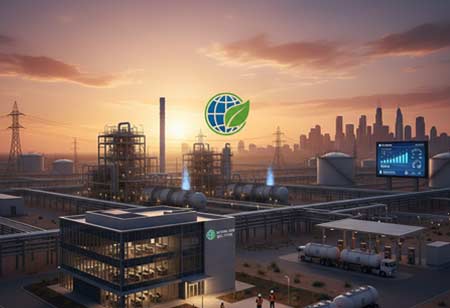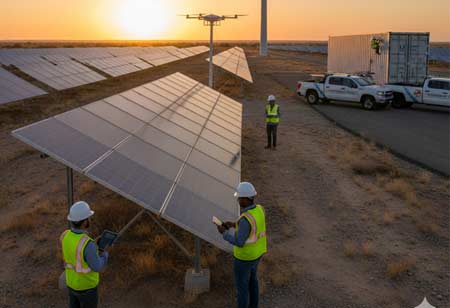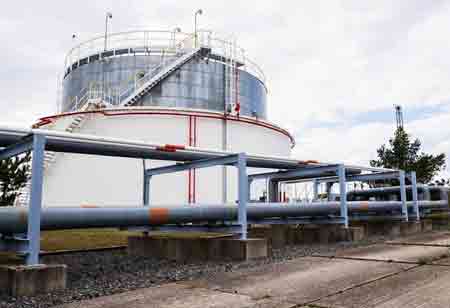Thank you for Subscribing to Energy Business Review Weekly Brief
Mapping the Future of Natural Gas in Developing Nations
Natural gas plays a vital role in the energy transition in developing economies, providing cleaner energy, driving economic growth, and improving living standards through infrastructure development and market reforms.

By
Energy Business Review | Tuesday, September 30, 2025
Stay ahead of the industry with exclusive feature stories on the top companies, expert insights and the latest news delivered straight to your inbox. Subscribe today.
Natural gas is becoming a cornerstone of the energy transition in developing economies, offering reliable, scalable, and cleaner energy that fuels economic growth and enhances living standards. As emerging markets chart a course toward industrialization and prosperity, the strategic development of natural gas resources and infrastructure is becoming a central pillar of national energy policy. This shift is not merely about switching fuel sources; it represents a fundamental reshaping of the energy landscape, driven by advancements in infrastructure, enhanced market affordability, and a clear vision for universal energy access.
The Great Build-out: A Foundation for Energy Security
Across the emerging world, a wave of ambitious infrastructure development is laying the foundation for a gas-based economy, building a comprehensive value chain that links resources to consumers with unprecedented efficiency. At the heart of this transformation are large-scale pipeline networks—both transnational and domestic—that are creating integrated energy corridors, strengthening regional cooperation, and enabling the movement of vast gas volumes from production hubs to demand centers. These steel arteries are vital for ensuring a stable and abundant energy supply that powers industries, supports agriculture, and illuminates cities.
Complementing this terrestrial expansion is the rapid proliferation of Liquefied Natural Gas (LNG) infrastructure. LNG import terminals are providing coastal nations with access to the global gas market, diversifying their energy mix and enhancing their energy security. The technology behind these facilities has undergone significant evolution. Floating Storage and Regasification Units (FSRUs), for instance, offer a flexible and faster-to-deploy alternative to traditional onshore terminals, allowing markets to scale their import capacity in line with growing demand. On the supply side, new liquefaction plants are enabling gas-rich nations to monetize their resources and participate more actively in international energy trade.
The final piece of this infrastructure puzzle is the expansion of City Gas Distribution (CGD) networks. These localized grids are a conduit for progress, bringing piped natural gas directly to homes, commercial establishments, and small industrial units. The methodical expansion of these networks into new urban and semi-urban areas is creating a modern energy ecosystem from the ground up.
Evolving Markets and Enhanced Affordability
The expansion of physical infrastructure is occurring in parallel with a profound evolution in market dynamics, making natural gas more affordable and accessible than ever before. A key driver of this trend is the deepening liquidity and globalization of the LNG market. With a greater number of suppliers and a more robust spot market, buyers have more options and greater leverage, leading to more competitive and transparent pricing. This global marketplace allows emerging economies to procure energy on flexible terms that suit their needs, moving away from rigid, long-term contracts.
Simultaneously, domestic market reforms are playing a pivotal role. Many governments are actively liberalizing their energy sectors, encouraging private investment and fostering competition across the gas value chain. These regulatory shifts are designed to improve operational efficiency and ensure that the benefits of lower global prices are passed on to consumers. By creating a level playing field, these reforms are attracting capital and expertise, accelerating the development of essential infrastructure and services.
Furthermore, the emergence of regional gas hubs and trading platforms is enhancing price discovery. These hubs provide a transparent reference point for transactions, thereby reducing volatility and enabling consumers to manage their energy costs better. The move toward market-based pricing mechanisms is a sign of a maturing industry, one that is increasingly responsive to the economic realities of consumers in developing nations. Technological innovation in areas like small-scale LNG is also contributing to affordability by enabling modular, phased deployment that can serve remote regions or specific industrial clusters without the massive upfront costs associated with large-scale pipeline infrastructure.
Expanding Energy Access and Catalyzing Progress
Ultimately, the goal of building infrastructure and ensuring affordability is to expand energy access, a powerful catalyst for both human and economic development. The arrival of natural gas in communities previously reliant on traditional biomass or expensive imported fuels has a transformative effect.
For households, the switch to piped natural gas for cooking and heating brings immense benefits. It eliminates indoor air pollution associated with burning wood or kerosene, leading to significant public health improvements. It also offers a more convenient, reliable, and often cheaper source of energy, freeing up time and household income for other essential needs.
For the industrial sector, ranging from large manufacturing plants to small and medium-sized enterprises, access to a consistent supply of natural gas is a game-changer. It provides a clean and efficient fuel for industrial processes, heat generation, and on-site power production, boosting productivity and global competitiveness. This reliable energy supply encourages industrial expansion and job creation, forming the backbone of an economy.
Moreover, natural gas is a vital enabler of a cleaner, more resilient power grid. Gas-fired power plants provide flexible, dispatchable electricity that can quickly ramp up or down to complement the intermittent nature of renewable energy sources, such as solar and wind. This symbiotic relationship is crucial, as it allows for a higher penetration of renewables into the grid without compromising stability, thereby supporting a balanced and sustainable energy transition. The use of compressed natural gas (CNG) in transportation is also growing, offering a cleaner fuel for public transit and commercial vehicle fleets, which helps improve air quality in congested urban centers.
The convergence of large-scale infrastructure investment, favorable market dynamics, and a clear focus on broadening energy access is creating a powerful engine for progress. By harnessing the potential of this cleaner fossil fuel, developing nations are building a more secure, affordable and sustainable energy future for future generations.






